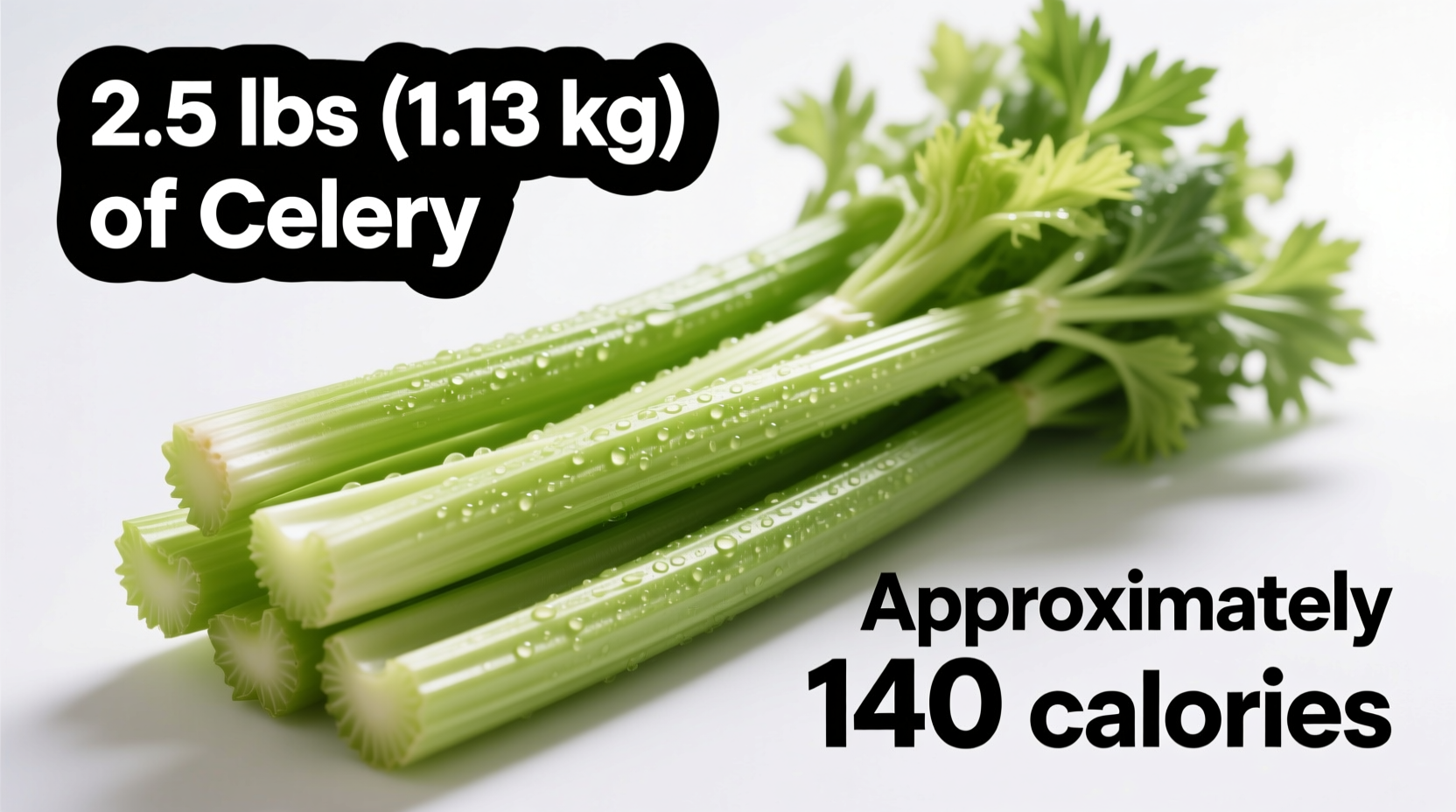Understanding exactly how many calories are in 2.5lb of celery matters whether you're meal prepping, tracking macros, or following a specific diet plan. Let's break down this nutritional information with verified data you can trust.
Breaking Down the Calorie Calculation
When you search for how many calories in 2.5lb of celery, you need more than just a number—you need to understand how that figure was determined. The USDA FoodData Central provides the most reliable nutritional information for accurate calculations.
According to the USDA National Nutrient Database:
- 1 cup of chopped celery (approximately 101g) contains 16 calories
- 1 pound of celery equals 453.592 grams
- Therefore, 2.5 pounds equals 1,133.98 grams
| Measurement | Weight | Calories |
|---|---|---|
| 1 cup chopped celery | 101g | 16 |
| 1 pound celery | 453.592g | 72 |
| 2.5 pounds celery | 1,133.98g | 180 |
Using this verified data, the calculation is straightforward: (1,133.98g ÷ 101g) × 16 calories = 179.6 calories, which rounds to 180 calories for practical dietary tracking.
Why This Calorie Count Matters for Your Diet
Celery's extremely low calorie density makes it valuable for various dietary approaches. Understanding calories in 2.5 pounds of celery puts this vegetable's nutritional profile into perspective:
- Represents only about 9% of a standard 2,000-calorie daily intake
- Contains just 15 calories per 100g, making it one of the lowest-calorie vegetables available
- Provides significant volume with minimal caloric impact—ideal for volume eating strategies
Unlike many low-calorie foods, celery delivers more than just water content. It contains valuable nutrients that contribute to overall health while keeping calorie counts low.
Celery's Nutritional Profile Beyond Calories
When considering how many calories in 2.5lb of celery, it's essential to recognize what those calories deliver nutritionally. Per 2.5 pounds (1,134g), celery provides:
- Potassium: Approximately 1,500mg (32% of daily value)
- Vitamin K: Around 100mcg (83% of daily value)
- Dietary Fiber: About 11g (44% of daily value)
- Vitamin A: Roughly 1,200IU (24% of daily value)
This nutrient density explains why celery remains popular in various dietary approaches despite its high water content. The fiber content particularly enhances satiety without adding significant calories.

Practical Applications for Meal Planning
Knowing the exact calorie count in 2.5 pounds of celery helps with practical meal planning. Here's how this information translates to real-world usage:
- Weight management: 2.5lb of celery provides substantial volume for just 180 calories, making it excellent for creating low-calorie, high-volume meals
- Hydration support: With 95% water content, this amount contributes significantly to daily fluid needs
- Meal prep: 2.5lb is a common grocery purchase size—knowing its caloric impact helps with accurate weekly planning
For context, 2.5 pounds of celery equals approximately 11-12 average-sized stalks, which would fill about 10-12 cups when chopped. This visual reference helps translate abstract weight measurements into practical kitchen terms.
Comparing Celery to Other Low-Calorie Vegetables
Understanding where celery stands among other vegetables provides valuable context for dietary decisions. The following comparison shows calories per pound for common vegetables:
| Vegetable | Calories per Pound | Calories in 2.5lb |
|---|---|---|
| Celery | 72 | 180 |
| Cucumber | 48 | 120 |
| Zucchini | 64 | 160 |
| Spinach (raw) | 140 | 350 |
| Broccoli | 140 | 350 |
This comparison reveals that while celery isn't the absolute lowest-calorie vegetable (cucumber takes that distinction), it remains among the most calorie-efficient options for adding volume to meals. The data comes from the USDA Food and Nutrition Information Center's comprehensive vegetable database.
Contextual Considerations for Calorie Counting
When using information about how many calories in 2.5lb of celery, several contextual factors affect practical application:
- Preparation method: Raw celery maintains its low calorie count, while adding dressings, dips, or cooking with oils significantly increases calories
- Individual variation: Actual calorie content can vary slightly based on growing conditions and specific celery variety
- Measurement accuracy: Home scales provide more precise measurements than volume-based estimates
For those following strict dietary protocols, weighing celery rather than measuring by volume delivers the most accurate calorie tracking. This precision matters most for individuals managing medical conditions or following highly structured nutrition plans.
Historical Perspective on Celery Nutrition
Nutritional understanding of celery has evolved significantly. Early 20th century food composition tables listed celery as having slightly higher calorie values due to less precise measurement techniques. Modern analytical methods have refined our understanding of celery's exceptionally low energy density.
According to historical data from the USDA's archived publications, early estimates suggested celery contained up to 20 calories per 100g. Contemporary analysis confirms the actual value is closer to 15 calories per 100g, demonstrating how improved scientific methods have enhanced nutritional accuracy.
Practical Tips for Incorporating Celery
Now that you know 2.5 pounds of celery contains 180 calories, here are practical ways to incorporate this knowledge:
- Use as a base for vegetable broth without adding significant calories
- Create crunchy snacks that provide volume with minimal caloric impact
- Add to smoothies for hydration and nutrients without dramatically affecting calorie counts
- Use as a vehicle for healthy dips like hummus while maintaining portion control
Remember that while celery's low calorie count makes it valuable for weight management, its true benefit comes from the combination of minimal calories with valuable nutrients and high water content.











 浙公网安备
33010002000092号
浙公网安备
33010002000092号 浙B2-20120091-4
浙B2-20120091-4